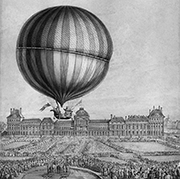E-Archive
Off the Beaten Track
in Vol. 13 - November Issue - Year 2012
Lighter Than Air

The first manned hydrogen balloon flight

Terrified farmers attack the first hydrogen balloon
“Cut the cloth, Nicolas, cut it quickly!” The urgency in his brother’s voice prompted Nicolas to fling open the toolbox on the floor of the gondola and to produce a long knife. As the other two passengers watched, Nicolas climbed up the riggings and quickly slashed the envelope, creating a ten-inch gash through which the hydrogen started hissing loudly. The balloon’s ascent gradually slowed down and its altitude stabilized a few minutes later. Disaster had been narrowly avoided.
********
The first recorded manned flight was in a hot air balloon in November 1783. Although many improvements to the structure followed in rapid succession, the main problem with hot air balloons was the excessive weight of the furnace and of the fuel, usually wood or coal, carried in the balloon’s basket and which generated the constant flow of hot air needed to keep the balloon afloat.
The Robert brothers, Nicolas-Louis and Anne-Jean, were two French engineers who worked out of a workshop in Paris in the late eighteenth century. Together with Professor Jacques Charles, they studied this problem and built the world’s first successful hydrogen balloon in 1783. The development of this invention required innovative solutions involving both the structure of the craft and the lifting element.
Professor Charles had studied the work of other researchers and had reached the conclusion that hydrogen would be a suitable lifting element for balloons, in substitution for hot air. To generate a quantity of hydrogen sufficient to lift a balloon, Charles invented a method in which sulphuric acid was poured onto scrap iron. The hydrogen thus created would be fed into the balloon envelope through a lead pipe. At first it proved very difficult to fill the envelope with this method, because Charles did not realize that the hydrogen, very hot when produced, would cool down rapidly and contract once inside the envelope. This meant that it would take much longer than expected to fill the envelope.
While Charles was busy designing the balloon and developing the passenger basket, the Robert brothers were inventing a cloth to be used as a gas bag for the balloon envelope. This new type of cloth would have to be airtight to prevent the hydrogen from leaking, but at the same time sufficiently light to avoid weighing down the entire structure. What they came up with was a method of dissolving rubber in turpentine and then spreading this solution on sheets of silk, previously stitched together to make the envelope.
The world’s first hydrogen-filled balloon was launched in August 1783. It was unmanned and relatively small, with a 35 m³ envelope capable of lifting only 9 kg. A quarter of a ton of sulphuric acid and half a ton of scrap iron were used to generate enough hydrogen to lift the craft. The public had taken a keen interest in this initiative and a large crowd gathered to watch as the balloon gently lifted off the field and flew northwards. It was chased by men on horseback and landed in a village about 20 kilometers away, where terrified farmers attacked the balloon with pitchforks.
Following the success of this experiment, Jacques Charles and the Robert brothers designed and built a much larger balloon, with a 380 m³ envelope fitted with a hydrogen release valve and covered with a net from which a basket for two passengers was suspended. Bags of sand were loaded for ballast. Amid great fanfare and in the presence of an estimated crowd of about 400,000, the world’s first manned hydrogen balloon was launched in Paris on 1st December 1783. The passengers were Jacques Charles and Nicolas-Louis Robert, who brought the craft to an altitude of about 550 meters and flew for two hours, covering a distance of 36 km. Among the guests of honor who witnessed the launch were Benjamin Franklin, U.S. Ambassador to France, and Joseph Montgolfier, one of the brothers who had designed and built the hot air balloon used in the world’s first manned balloon flight ten days earlier.
About seven months later, the Robert brothers and the Duke of Chartres flew in the first steerable balloon, or dirigible, designed by Jacques Charles. It had an elongated, cigar-shaped envelope and carried for the first time a boat-shaped basket which became known as a “gondola”. Lacking a hydrogen release valve on the envelope, the flight almost ended in disaster when the passengers were forced to cut a hole in the balloon in order to stop the ascent of the craft.
By Giovanni Gregorat, Contributing Editor MFN & Sales Manager, Pometon Abrasives
Author: Giovanni Gregorat



























